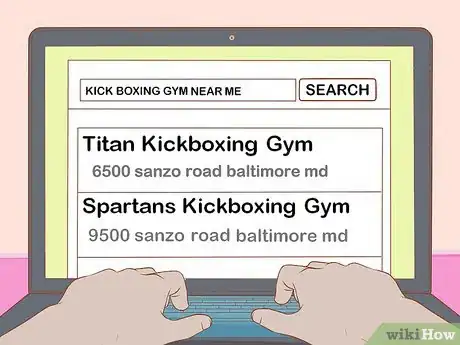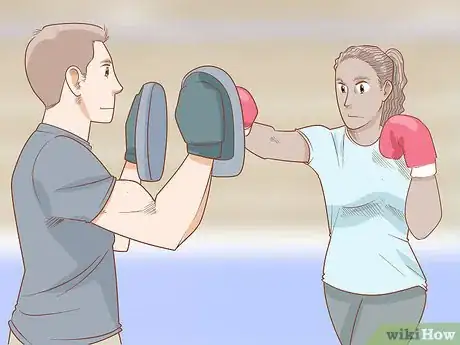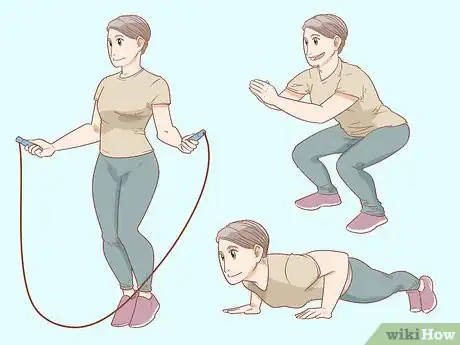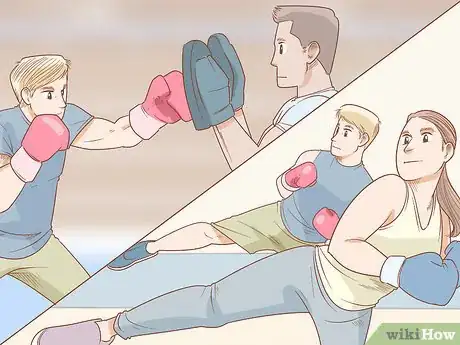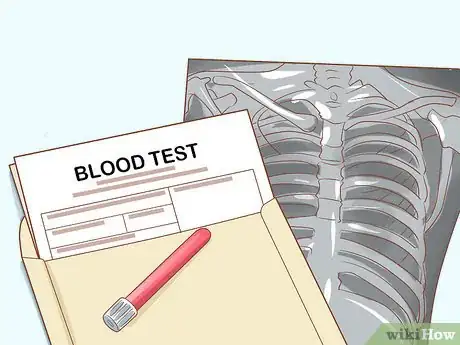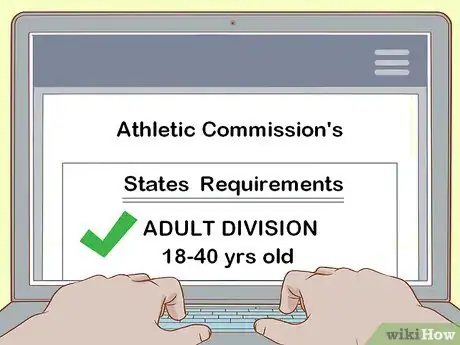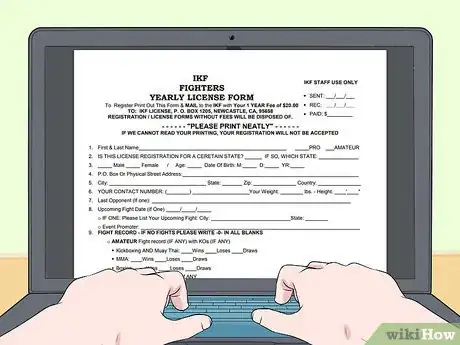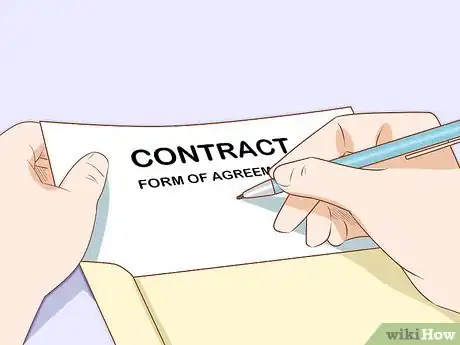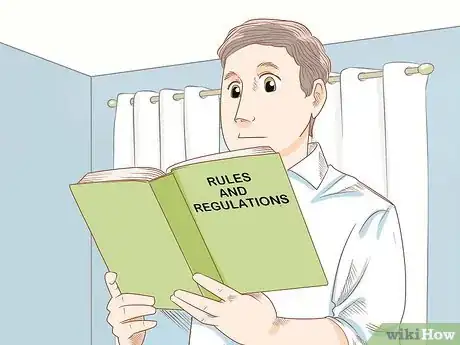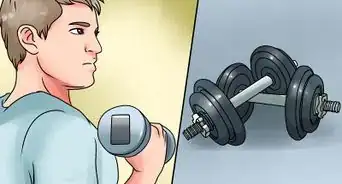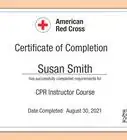This article was co-authored by David Engel. David Engel is a Muay Thai Instructor and Self Defense Trainer based in the San Francisco Bay Area. With over 15 years of martial arts instruction and training experience, David runs California Martial Athletics with co-owner Joe Chernay. He has created and maintained martial arts programs at Rise Combat Sports in San Francisco and Round 5 Martial Arts Academy in San Leandro, with a mission to provide students with a level of comfort and competency that manifests both within and outside the martial arts context. He is also a registered cornerman for amateur and pro competitors under the IKF (International Kickboxing Federation). David was the youngest apprentice instructor of the Thai Boxing Association of America under Ajarn Chai Sirisute (2009), and was a top-ranked amateur competitor in his weight class (127-130 lb) in California between 2013 and 2015.
There are 13 references cited in this article, which can be found at the bottom of the page.
This article has been viewed 65,052 times.
Kickboxing is a fusion of different fighting techniques that concentrate on punches and kicks. If you want to become a professional kickboxer, you must train hard and stay dedicated to the art. Once you've refined your skills, you should get started by sparring in class or fighting in some amateur bouts. Then, when you have the practical fighting experience, you can search for kickboxing promoters and get paid to fight professionally.
Steps
Training to Become a Kickboxer
-
1Search online to find kickboxing gyms and schools near you. Once you locate local gyms, use online ratings and reviews to narrow down your choices. Look at gym websites and social media accounts to get a sense of how the training is in different gyms. Determine if it offers classes for your age group and whether the classes would fit in your schedule.[1]
- Keep your options open and consider more than one school in your area.
- Consider going to a school that has trainers who are certified with the Aerobics and Fitness Association of America, the International Kickboxing Federation, or the International Sport Karate Association. You can usually find this information on their website.
- You can’t become a professional kickboxer without the proper training.
-
2Talk to an instructor and sign up for classes. Locate the gym’s contact information and give the school a call. Talk to the instructor about registering for classes and explain what your goals are so that they can tell you whether the school is for you. Some schools offer aerobic kickboxing while others train amateur and professional fighters for actual bouts. Find a gym that is currently training other fighters.[2]
- Look for a gym where you feel welcomed and supported. Good kick boxers need a strong support system, whether that's their friends, family, teammates, or coach.[3]
- Ask the trainer about what gear you should bring for your first class.
- Trainers who are ex pro-kickboxers may give you special insight to becoming a professional that others couldn’t.
Advertisement -
3Attend kickboxing class regularly. In order to get the skills, technique, and physical fitness to fight professionally, you’ll have to be dedicated and attend class regularly. As a beginner, you'll need to take classes 3 times a week, and work out on your own at least twice a week.[4] Most professional fighters will train 2-3 times per day 4-6 times per week. Talk to your trainer and ask them if they think you are ready before you try to get your first fight.[5]
- Most people will train for 4-6 months before their first competitive fight but everyone is different.
- Listen to your instructor carefully so that you can perfect different kickboxing techniques.
- You can generate more power in a punch or a kick with good technique than you can with brute force.
-
4Spar regularly to get comfortable with fighting. Sparring in class will get you acclimated at taking hits and throwing punches and kicks at an opponent. Sparring is also an amazing workout that can improve your conditioning, strength, and technique. Talk to your training partners and see if they would like to spar with you.[6]
- Don't rush into sparring; you need to get the fundamentals down first. Ask your instructor if you’re ready to spar before you start.[7]
-
5Perform cardio exercises to improve your endurance. Your endurance is essential when kickboxing. Common cardio exercises include running, jump rope, and doing drill exercises. The better your stamina is, the longer you’ll be able to go in the fight.[8]
- Include both long-distance running and sprints in your training, along with exercises like jump squats, lunges, jumping rope, swimming, and cycling.[9]
- You’ll work on cardio in kickboxing class but it’s also good to do the exercises on your free time.
-
6Attend a training camp before your fight. The average training camp will typically last anywhere from 6-8 weeks and will be an intensified version of training. You will usually be training at least 5-6 days per week during this time. Talk to your coach about running a training camp before your first bout. You’ll refine your stamina, strength, and technique during the camp and get into the best fighting condition.[10]
- If your coach can’t run a training camp, call other gyms in the area to see if they have the capacity and staff to run one.
Completing Legal Paperwork and Requirements
-
1Get a physical examination and blood test. You will have to take a blood test and undergo an athletic physical before you can register to become a professional fighter or join a kickboxing organization. If you're older than 37-years-old, you may also have to undergo additional tests like an eye or neurological exam.[11]
- Depending on where you live, examination requirements will differ. Visit your state athletic commission's website to find which tests you need to complete.
- Fighters older than 37 may have to be medically cleared by a doctor before they can fight professionally.
-
2Meet the age requirements according to your state. Most laws restrict people that are 18 to fight in professional bouts. Visit your state athletic commission's website to see the age requirements for your state. If you are older than 30-years-old then you should also see any restrictions or requirements required before you can apply for a license.[12]
-
3Obtain fighting licenses or certificates required by your state. States like Pennsylvania and California have licenses that you must get as a professional and even amateur fighter. Before you can get paid to fight, visit your state’s athletic commission’s website and read up on what certificates are required. Then, fill out the paperwork to register as a professional kickboxer and wait for them to issue your license.[13]
- Kickboxing promoters will require proof of a license if it’s required in your state before booking you for a professional fight.
-
4Join a kickboxing association. Kickboxing associations like The World Kickboxing Association (WKA) and International Kickboxing Federation (IKF) require registration before you can participate in fights promoted by these organizations. These organizations each have their own set of rules, restrictions, and requirements that have to be fulfilled before you fight for their franchise. Visit their websites to fill out any forms you need to register.[14]
Going Pro
-
1Participate in amateur bouts before going pro. Talk to your instructor about participating in amateur fights. They may know of promoters or events in your area that you can fight in. This will give you experience in the ring without thrusting you against much more experienced professional opponents. Amateur fights are not required in order to go pro but most fighters will usually have somewhere around 5-10 amateur wins before trying to go to the next level.[15]
- Unlike a professional, amateur fighters are less experienced and don’t get paid to fight.
- If you don’t like participating in amateur fights, there’s a good chance you wouldn’t like to fight professionally.
-
2Consider hiring a manager. Managers can help explain contracts, negotiate higher pay, and will help set up fights for you. If you just want to fight and don’t want to deal with the details, look to sign a manager. Network with those you train with and seek out people who are already managing fighters or ex-professional fighters.[16]
- Managers typically take anywhere from 10% - 20% of your fight winnings.
-
3Contact kickboxing promoters in your area. Find promoters who put on events that you’ve gone to or ask people at your gym about which promoter they use. If you can’t find any that way, use a search engine to find local promoters who put on kickboxing events near you. Contact the promoter and tell them that your a professional fighter who is looking for a fight.[17]
- If you live in a smaller town, you may have to search in the closest city near you.
-
4Get matched up with someone at a similar skill level. Don’t just agree to fight anyone in your first professional fight. Look to face off against someone with similar experience and skills. If you believe that the fight is a mismatch or that your opponent has too much experience, speak with the fight promoter about the matchup and request to fight someone else.[18]
- You can say something like, “My opponent already has 10 pro fights and is undefeated. I think that it’s an unfair matchup and I don’t want to take the fight. Can we find someone else that’s at a similar skill level?”
-
5Sign the contract for your first professional fight. The promoter will outline when and who you’ll be fighting in a contract. The contract will also include your pay and any other stipulations regarding the bout, like weight restrictions and special rules. Once you’ve read the contract and are okay with it, sign it to set your fight in stone.[19]
- There may be a financial penalty in the contract for not making weight or dropping out of the fight.
- If you don’t like something in the contract, bring it up to the kickboxing promoter before you fight.
-
6Learn the rules and regulations for your specific bout. Make sure to fully educate yourself on the set of rules for the bout. Ask the promoter for the rules or read your contract to see what they are. Incorporate the rules for your fight during training and sparring so that you can get used to fighting that way.[20]
- Many fights use a standard pre-set rules that have been defined by their state athletic commission or a kickboxing organization.
- For instance, many Muay Thai fights allow elbows and knees, while traditional kickboxing rules only allow punches and kicks.
- If you break a rule during the fight you could be deducted points or even disqualified.
-
7Train and prepare thoroughly before your fight. Monitor your weight so that you can make the weigh-in and make sure that you’re mentally and physically prepared for the fight. If you trained hard and stayed focused, you should be prepared for your first professional fight.[21]
- After you have a fight and get paid for it, you’re officially a pro fighter.
Expert Q&A
-
QuestionHow often should I take kickboxing classes?
 David EngelDavid Engel is a Muay Thai Instructor and Self Defense Trainer based in the San Francisco Bay Area. With over 15 years of martial arts instruction and training experience, David runs California Martial Athletics with co-owner Joe Chernay. He has created and maintained martial arts programs at Rise Combat Sports in San Francisco and Round 5 Martial Arts Academy in San Leandro, with a mission to provide students with a level of comfort and competency that manifests both within and outside the martial arts context. He is also a registered cornerman for amateur and pro competitors under the IKF (International Kickboxing Federation). David was the youngest apprentice instructor of the Thai Boxing Association of America under Ajarn Chai Sirisute (2009), and was a top-ranked amateur competitor in his weight class (127-130 lb) in California between 2013 and 2015.
David EngelDavid Engel is a Muay Thai Instructor and Self Defense Trainer based in the San Francisco Bay Area. With over 15 years of martial arts instruction and training experience, David runs California Martial Athletics with co-owner Joe Chernay. He has created and maintained martial arts programs at Rise Combat Sports in San Francisco and Round 5 Martial Arts Academy in San Leandro, with a mission to provide students with a level of comfort and competency that manifests both within and outside the martial arts context. He is also a registered cornerman for amateur and pro competitors under the IKF (International Kickboxing Federation). David was the youngest apprentice instructor of the Thai Boxing Association of America under Ajarn Chai Sirisute (2009), and was a top-ranked amateur competitor in his weight class (127-130 lb) in California between 2013 and 2015.
Muay Thai Instructor & Self Defense Trainer Start off by taking kickboxing classes 3 times a week. In addition, you'll need to work out independently at least twice a week.
Start off by taking kickboxing classes 3 times a week. In addition, you'll need to work out independently at least twice a week. -
QuestionHow many kicks per round do I have to attempt?
 Community AnswerIt depends on how many you land in a particular round. There are about 5 rounds in professional kickboxing. If you're accurate, you'll need fewer kicks.
Community AnswerIt depends on how many you land in a particular round. There are about 5 rounds in professional kickboxing. If you're accurate, you'll need fewer kicks. -
QuestionWhat kickboxing belts do I get from white to black?
 Community AnswerThe belt colors and how they're attained differ depending on which school you attend.
Community AnswerThe belt colors and how they're attained differ depending on which school you attend.
References
- ↑ https://www.self.com/story/boxing-classes-what-to-know-before-go
- ↑ https://www.self.com/story/boxing-classes-what-to-know-before-go
- ↑ David Engel. Muay Thai Instructor & Self Defense Trainer. Expert Interview. 5 May 2020.
- ↑ David Engel. Muay Thai Instructor & Self Defense Trainer. Expert Interview. 5 May 2020.
- ↑ https://www.cosmopolitan.com/career/interviews/a37374/get-that-life-mikaela-mayer-boxing/
- ↑ http://www.sammyfranco.com/sparring.html
- ↑ David Engel. Muay Thai Instructor & Self Defense Trainer. Expert Interview. 5 May 2020.
- ↑ https://breakingmuscle.com/fitness/fighters-abs-train-like-a-kickboxer
- ↑ David Engel. Muay Thai Instructor & Self Defense Trainer. Expert Interview. 5 May 2020.
- ↑ https://www.cosmopolitan.com/career/interviews/a37374/get-that-life-mikaela-mayer-boxing/
- ↑ http://www.abcboxing.com/medical-requirements-by-commission/
- ↑ http://www.ikfkickboxing.com/ToFightForIKF.htm
- ↑ http://www.ikfkickboxing.com/ToFightForIKF.htm
- ↑ http://www.ikfkickboxing.com/IKFHistory.htm
- ↑ https://www.cosmopolitan.com/career/interviews/a37374/get-that-life-mikaela-mayer-boxing/
- ↑ https://mmajunkie.com/2017/10/do-ufc-fighters-need-managers-aljamain-sterling-malki-kawa
- ↑ https://www.quora.com/How-do-I-become-a-professional-kickboxer
- ↑ https://www.expertboxing.com/boxing-strategy/fight-tips/winning-your-first-pro-fight
- ↑ https://www.quora.com/How-do-I-become-a-professional-kickboxer
- ↑ http://www.ikfkickboxing.com/RulesMain.htm
- ↑ https://breakingmuscle.com/fitness/a-day-in-the-life-of-a-muay-thai-fighter
